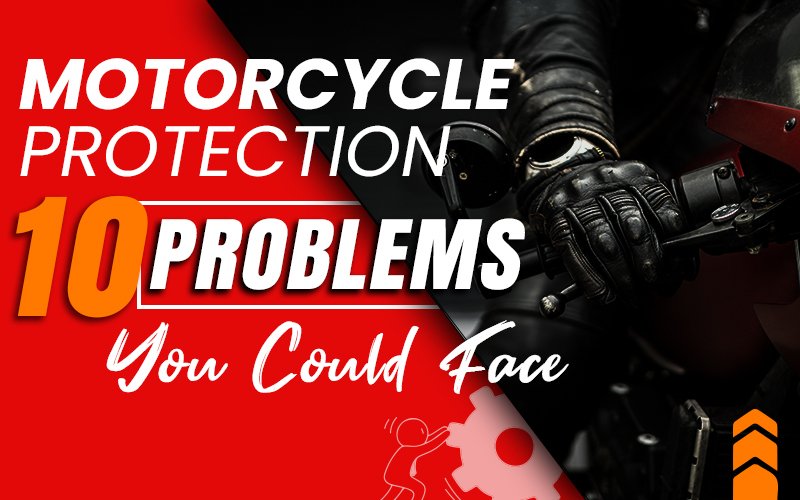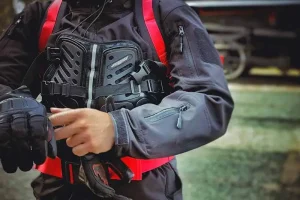
-
By Jenson Castillo

Revving engines, wind blowing into your hair, and the open road calling; the satisfaction of motorcycle riding is undeniable. Yet, beneath the thrill lies a crucial need for caution and a state of being prepared. As any seasoned rider will tell you, the road is full of surprises, and without the right Motorcycle Protection, those surprises can quickly turn into challenges.
Let’s dive into the world of motorcycle protection and uncover the 10 problems you could face on your two-wheeled adventures, making them safe, fearless, and much more enjoyable than ever.

Is riding a motorcycle unsafe? Unfortunately, the answer to that is “Yes”. Aside from the thrill of riding a motorcycle, there is also a con that is known as unpredictable accidents.
Although they can’t be foreseen they can be minimized to help you avoid fatal crashes. Motorcycle protection is crucial for rider safety. It minimizes injury risk in accidents by providing physical and impact protection, reducing abrasions, and safeguarding against weather conditions. Additionally, it enhances visibility, complies with legal requirements, and contributes to a more comfortable riding experience.
These are the types of risks that we can not control but can be they can be foreseen and can also be prevented, below are some factors along with their preventions:
-Risk:Adverse weather conditions like rain, snow, or storms can reduce visibility and road traction.
-Prevention:Check weather forecasts before riding and equip yourself with appropriate gear for different conditions.
-Risk:Poorly maintained roads, potholes, or uneven surfaces can pose dangers to riders.
-Prevention:Stay alert, follow traffic signs, and adjust speed according to road conditions.
-Risk:Heavy traffic increases the likelihood of accidents and may lead to rider frustration.
-Prevention:Plan routes to avoid peak traffic hours, maintain safe following distances, and practice patience.
-Risk:Other motorists distracted by phones or other factors may not be fully aware of motorcyclists.
-Prevention:Stay visible, anticipate potential hazards, and avoid riding in blind spots.
-Risk:Aggressive or reckless drivers may pose a significant threat to motorcyclists.
-Prevention:Practice defensive riding, be cautious around aggressive drivers, and report any unsafe behavior.
-Risk:Construction zones can have unpredictable road surfaces and traffic patterns.
-Prevention:Slow down in construction zones, follow signage, and be aware of changing road conditions.
-Risk:Animals crossing roads can catch riders off guard, leading to accidents.
-Prevention:Stay attentive, especially in rural areas, and reduce speed in wildlife-prone zones.
-Risk:Low visibility, especially during dawn, dusk, or nighttime, increases the chances of accidents.
-Prevention:Use reflective gear, ensure proper lighting on the motorcycle, and avoid riding in conditions with poor visibility.
-Risk:Unexpected breakdowns due to mechanical issues can leave riders stranded.
-Prevention:Regularly maintain and inspect your motorcycle, addressing any issues promptly.
-Risk:Changes in traffic laws or regulations may impact riding conditions.
-Prevention:Stay informed about local laws, attend rider safety courses, and adapt riding habits accordingly.
Navigating these macro risks requires a combination of preparedness, caution, and adherence to safety measures. Riders should stay vigilant, continuously improve their skills, and prioritize safety on the road
-Solution: Invest in a high-quality, well-fitted helmet.
-With What: Research and choose a helmet from reputable brands with proper certifications.
-Solution: Prioritize quality riding gear for comprehensive protection.
-With What: Invest in durable jackets, gloves, boots, and pants made for motorcycle riders.
-Solution: Regularly inspect and maintain your bike’s braking system.
-With What: Use manufacturer-recommended brake fluids and schedule routine checks.
-Solution: Adhere to a strict tire maintenance schedule.
-With What: Check tire pressure, tread depth, and overall condition regularly.
-Solution: Routinely inspect and maintain electrical components.
-With What: Use dielectric grease for connections and follow the manufacturer’s maintenance guidelines.
-Solution: Perform regular checks on the ignition system.
-With What: Clean and lubricate ignition components as recommended by the manufacturer.
-Solution: Adhere to a consistent oil change schedule.
-With What: Use high-quality motorcycle oil recommended for your bike’s engine.
-Solution: Regularly check and adjust suspension settings.
-With What: Consult the motorcycle manual for proper suspension maintenance guidelines.
-Solution: Keep the motorcycle chain clean and well-lubricated.
-With What: Use a suitable chain cleaner and lubricant, following the manufacturer’s recommendations.
-Solution: Implement robust security measures to deter theft.
-With What: Utilize disc locks, alarms, and secure parking spaces to safeguard your motorcycle.
By proactively addressing these problems with appropriate measures and using recommended products, riders can significantly enhance the safety and longevity of their motorcycles.

Regular maintenance is important for bike riders primarily for safety reasons and great performance. Keeping key components in top condition ensures that the bike operates safely on the road, reducing the risk of accidents caused by mechanical issues. Additionally, routine maintenance enhances the overall performance of the motorcycle, improving fuel efficiency, acceleration, and responsiveness. By addressing potential problems proactively, riders can increase the reliability of their bikes, minimizing the chances of unexpected breakdowns and ensuring a safer and more enjoyable riding experience.
Before embarking on a motorcycle ride, it’s essential to perform a quick yet comprehensive check to ensure safety and optimal performance. Here’s a short list of key things to look at during pre-ride maintenance:
1. Tires:
Check tire pressure and ensure they have sufficient tread depth. Look for any visible damage.
2. Brakes:
Test both front and rear brakes to ensure they respond effectively. Check brake fluid levels.
3. Lights and Indicators:
Verify that all lights (headlights, brake lights, turn signals) are functioning properly.
4. Oil Level:
Check the engine oil level and top up if necessary, adhering to the manufacturer’s recommendations.
5. Suspension:
Inspect the suspension for any leaks or abnormalities. Ensure it operates smoothly.
6. Chain (or Belt/Shaft):
For chain-driven bikes, check tension, and lubrication, and look for signs of wear. For belt or shaft-driven bikes, inspect for any visible issues.
7. Fluids:
Check levels of other essential fluids such as coolant and transmission fluid.
8. Controls:
Test the clutch and throttle for smooth operation. Ensure the handlebars and levers are secure.
9. Battery:
Verify that the battery is charged and secure. Clean any corrosion if present.
10. Mirrors:
Adjust and ensure both mirrors are clean for optimal visibility.
11. Fuel:
Confirm that you have enough fuel for your intended ride.
12. Emergency Tools:
Carry basic tools like a tire pressure gauge, wrench, and a small toolkit for minor adjustments.
Performing these checks before each ride contributes to a safer and more enjoyable motorcycle experience. Regular maintenance not only enhances safety but also prolongs the life of your bike.
Prioritizing regular maintenance before embarking on a motorcycle ride is not just a recommended practice; it’s a fundamental aspect of responsible riding. The concise checklist provided serves as a quick yet comprehensive guide for riders to ensure their safety, the longevity of their bikes, and the overall quality of their riding experience.
By carefully inspecting critical components like tires, brakes, lights, and fluids, riders can significantly reduce the risk of accidents caused by mechanical failures. The emphasis on tire pressure and tread depth underscores the importance of maintaining optimal traction, essential for safe maneuvering on varied road conditions. Moreover, a thorough examination of the brakes ensures that riders can rely on their stopping power when needed the most.
Engine health is addressed through checks on oil levels and other vital fluids, emphasizing the significance of a well-lubricated and efficiently running motorcycle. The attention given to the suspension system not only contributes to a smoother ride but also ensures stability and control, factors crucial for navigating unpredictable terrains.
In the end, a well-maintained motorcycle is not just a safer ride; it’s a more enjoyable one. The rider who invests time in pre-ride checks is not only safeguarding their well-being but also prolonging the life and performance of their trusted machine. Riding enthusiasts are encouraged to view these maintenance practices not as a chore but as a proactive investment in the longevity, reliability, and overall pleasure derived from their two-wheeled adventures. By incorporating these habits into their routine, bikers can hit the road with confidence, knowing that their motorcycle is primed for a safe and exhilarating journey.
Share :
Subscribe to our fortnightly newsletter with stories from our latest adventures and the best travel tips